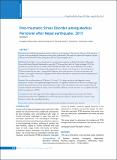Please use this identifier to cite or link to this item:
https://hdl.handle.net/20.500.14356/1751| Title: | Post-traumatic Stress Disorder among Medical Personnel after Nepal earthquake, 2015 |
| Authors: | Shrestha, R |
| Citation: | ShresthaR. (2015). Post-traumatic Stress Disorder among Medical Personnel after Nepal earthquake, 2015. Journal of Nepal Health Research Council. https://doi.org/10.33314/jnhrc.v0i0.639 |
| Issue Date: | 2015 |
| Publisher: | Nepal Health Research Council |
| Article Type: | Original Article |
| Keywords: | Â Disaster Healthcare professional Nepal Post-traumatic stress disorder |
| Series/Report no.: | May-Aug, 2015;639 |
| Abstract: | Abstract Background: Health professionals involved in a disaster are not immune to the stressors. However, little attention is given on the psychological consequences among these professionals. This study has explored the frequency of posttraumatic stress disorder (PTSD) among them after the Nepal earthquake 2015. Methods: A descriptive cross sectional study was carried out amongst the medical professionals at Manmohan Memorial Teaching Hospital, Kathmandu to assess the PTSD among them after the Nepal earthquake 2015. Two months after the post disaster the standard PTSD Checklist for DSM-5 (PCL 5) was administered to medical personnel of a hospital(n=64) along with demographic features, disaster related experience and working hours. PTSD was defined by two ways: 1.using DSM V diagnostic criteria (the presence of at least one intrusion, one avoidance, two negative alterations in cognitions/mood and two alterations in arousal and reactivity symptoms); and 2. a cutoff score of 30. Results: The overall prevalence of PTSD was 21.9% and 17.1% using cutoff score and diagnostic criteria respectively. Females scored significantly higher than males. No significant difference was observed according to age, marital status, profession, previous disaster xperience, tragic events with relatives. Those who were present in the hospital during the initial influx of victims, witnessed patients suffering, worked extra time were at significantly high risk for development of PTSD. Conclusions: This study suggest that PTSD is highly prevalent among healthcare professionals after disaster management and therefore it highlights the need for targeted interventions to specific staff who respond to large disasters to reduce the psychological burden. Keywords: Disaster; earthquake; healthcare professional; Nepal; post-traumatic stress disorder. |
| Description: | Original Article |
| URI: | http://103.69.126.140:8080/handle/20.500.14356/1751 |
| ISSN: | Print ISSN: 1727-5482; Online ISSN: 1999-6217 |
| Appears in Collections: | Vol. 13 No. 2 Issue 30 May - August 2015 |
Files in This Item:
| File | Description | Size | Format | |
|---|---|---|---|---|
| 639-Article Text-1175-1-10-20151231.pdf | Fulltext Download | 223.88 kB | Adobe PDF |  View/Open |
Items in DSpace are protected by copyright, with all rights reserved, unless otherwise indicated.
